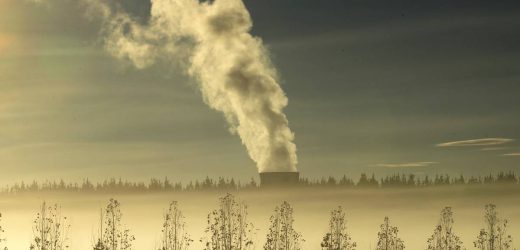As part of the global Covering Climate Now initiative, the Herald is dedicating a week of coverage to the issues surrounding the climate crisis. In the first of a series of in-depth interviews with leading experts on key policy areas, Herald science reporter Jamie Morton speaks with Emeritus Professor Ralph Sims, of Massey University, about how we can make New Zealand’s energy sector greener.
As of 2018, heat, industry and power emissions made up some 41 per cent of total long-lived greenhouse gases in New Zealand. Why do these sectors contribute such a large share of our emissions?
Many industries still burn coal and gas to provide high to medium temperature heat for their processes such as smelting steel, drying milk, growing greenhouse crops, or producing cement.
The Government has recently announced policies and grants to encourage businesses to displace these fossil fuels with high-temperature heat pumps, electro-thermal technologies, and sustainably produced biomass to meet their heat demands.
Electricity generation in New Zealand is mainly from low-carbon renewable resources like hydro, wind, geothermal, bioenergy, solar – but at present around 15 per cent of total electricity still comes from burning coal and gas that produce carbon dioxide (CO2).
A coal-fired power station such as Huntly emits around 900g CO2/kWh generated, and gas-fired plants emit around 600g CO2/kWh.
Renewable electricity, however, is closer to zero, with the exception of geothermal that releases around 20 to 40g CO2/kWh, when extracting the hot brine.
So, what barriers have been in the way of decarbonising these sectors?
Coal and gas have been relatively cheap fuels in New Zealand, even with a carbon price added under the Emissions Trading Scheme (ETS).
New Zealand has been very slow to act compared with, say, Sweden that introduced a carbon charge on fossil fuels 30 years ago.
That tax is now around $180 per tonne of CO2, so has made a difference to fossil fuel consumption – whereas the ETS price in NZ has only slowly crept up to $35 per tonne over the past few years.
This price remains far too low to have any real impact on behavioural change or encouraging businesses to move away from using fossil fuels.
After the carbon tax was imposed in Sweden, biomass – mainly from forest residues and municipal solid wastes – soon became the common heating fuel, with a large supply industry now well established.
It employs many people to provide solid biomass fuels to numerous district heating, industrial heating and co-generation plants.
This week, the Government announced New Zealand would seek to phase out coal boilers for process heat by 2037 – starting with a ban on new low to medium temperature boilers from next year. What difference will this make? And is it ambitious enough?
The concept has been analysed and promoted in New Zealand for decades given the relatively high CO2 emissions involved.
So the Government policy to ban installation of new coal-fired boilers is long overdue.
Given that a molecule of CO2 emitted from a gas or coal-fired boiler today – or over the next 16 years until 2037 – will remain in the atmosphere for hundreds of years and thereby add to the global warming effect, a policy to encourage deployment of low-carbon heating systems should have been implemented years ago.
Many examples already exist in New Zealand of successful and cost-effective electro-thermal, solar thermal and bioenergy heating systems, as well as using geothermal heat in regions where it is available.
Technological developments to improve biomass boiler efficiencies have long been demonstrated in countries such as Austria, Denmark, Thailand and elsewhere.
Partly depending on the future carbon price, it is likely some operators of coal-fired boilers will phase them about before the end of their life.
The Government also has its own fleet of coal boilers still operating in schools and public buildings.
Hopefully, it will lead by example and phase them out well before 2037.
A further 16 years of continuing to emit CO2 emissions from coal combustion is simply not tolerable.
We’ve heard much discussion about New Zealand’s 2035 target for an electricity grid using solely renewable sources of energy. Is this realistic?
Achieving 100 per cent renewable electricity is technically possible, but not cost-effective, based on current technologies.
Continual fluctuations in the national electricity load means the generation system has to be able to quickly respond to maintain voltage and security of supply since electricity cannot be easily stored.
With more variable wind and solar generation now in the mix, the challenge to continually meet supply with demand has increased.
The electricity industry strives to produce an affordable and sustainable supply that is reliable.
Consumers expect the system to work at all times and become disgruntled with their electricity company whenever there is an outage.
Peak demand loads in the mornings and evenings used to be managed by the power companies controlling domestic hot water heating systems using “ripple control” to turn them off at peak times and on again once the peak had passed.
Consumers knew no difference.
This demand-side facility has been lost under the free-market we now have, though other demand-side options exist such as paying cool-store operators to turn their refrigeration plants off for an hour or two at peak times, aiming to flatten the peak.
The bigger challenge than meeting daily peaks is to meet seasonal demands, especially in a dry year when the hydro lakes are low so generation is constrained.
As one possible solution, the Government is investigating using a pumped-hydro scheme to store large volumes of water behind a dam for use when additional power is needed.
Battery storage is also becoming cheaper and large-scale storage systems have been demonstrated in South Australia and elsewhere.
But there is a cost associated with any form of energy storage.
Making the grid more flexible – such as by using demand-side options and time-of-use pricing – is a part solution.
But it could be that on rare occasions when needed, a back-up gas-fired power plant could be kept on standby for limited use.
Or, a number of bioenergy plants built with the woody biomass fuel could provide a store of energy, as is common in Sweden and elsewhere.
Since they would only be run when needed in dry years, the Government will need to own and operate them.
Electrifying our energy use is a major part of New Zealand’s “just transition” away from fossil fuels – but it would require a major expansion of the electricity system. Is it possible for sources like wind, geothermal and solar power to meet the expected growth in demand from electrifying transport and heat to 2050, while keeping electricity affordable?
The projected increasing demand for electricity for process heat, domestic heat, and electric vehicles has been assessed.
Improving energy efficiency, so that the same energy services are provided but with lower energy inputs, will help to control the demand growth.
Further improving energy efficiency further across all sectors is a critical part of moving towards renewable energy systems.
Educating consumers how to save electricity and hence save money is a key component.
New Zealand is blessed with large resources of wind, solar radiation, biomass, geothermal fields and hydro, which is why we have reached around 85 per cent renewable electricity without any government subsidies that are common in most other countries.
Many wind farms and geothermal sites that can compete economically with gas-fired power plants have been consented but not yet built.
Solar farms covering several hectares of land each are now being developed, and more home-owners are investing in solar PV systems and using them to also charge their EVs.
The main problem is the incumbent electricity market, consisting of generators, line companies and retailers, is not designed to readily adapt to changing technologies.
Many of the “old school” were educated that electricity is generated in large central power stations and sent down wires to users who are distributed.
The advent of smart-grids, distributed generation systems, solar heating, and other small-scale generators has not been fully accommodated by the market that is resisting change.
Therefore, the goal should be for a think-tank to determine what the future market should look like in order to generate affordable and reliable electricity to meet the growing demand but without producing CO2 – and then to determine how we best get from where the system is to where it needs to be.
Given all our renewable resources and the rapid rate of technological developments, it shouldn’t be difficult.
There’s also growing interest and investment in “green hydrogen” as a viable alternative fuel source – and one that could provide a sustainable future for the oil and gas industry. What hope and potential is there here?
The concept for a hydrogen economy has come and gone in recent decades but is currently being reconsidered in many countries, including New Zealand.
Most hydrogen is currently produced from natural gas (brown hydrogen) or industrial processes (grey hydrogen) so is linked with greenhouse gas emissions.
Its future therefore has to be around producing low-carbon “green hydrogen” using renewable electricity.
Hydrogen cars have been around for decades and a hydrogen bus is now running around Auckland with a refuelling station at the Port of Auckland.
Also, a Massey University project 20 years ago, in association with Callaghan Innovation, produced hydrogen for use by a small rural community, using a small wind turbine on top of a hill to power an electrolyser.
The point is that hydrogen as an energy carrier is not a new concept whether for electricity generation, heat supply or transport fuel.
The question is whether now is the right time for its wider deployment.
Japan, the European Union, the UK and other countries are moving along the hydrogen pathway, but there are issues to overcome.
On the downside, green hydrogen is more costly to produce than other sources though electrolysers, like batteries, are becoming cheaper.
Also, there is a considerable energy efficiency loss throughout the entire system.
For example, generating electricity used for electrolysis of water to give hydrogen that is then stored before combustion or conversion to electricity in a fuel cell is a far less efficient process (around 30 per cent) than generating electricity for direct use (around 80 per cent).
The main benefit from the hydrogen route is that it can be relatively easily stored compared with electricity and with possible marine and aviation applications.
So once again in regard to a future hydrogen economy it is a case of “watch this space”.
You’ve long been a proponent of a “bio-economy”. Can you recap what this is? And why do you believe it would be a good model for New Zealand?
Using woody biomass, straw, animal manure, sewage, municipal solid wastes to produce useful bioenergy for heat, power or transport biofuels is commonplace around the world.
When biomass is combusted, CO2 is produced during the process the same as when burning fossil fuels.
However, instead of the carbon being suddenly released into the atmosphere after millions of years of being stored underground, the CO2 from biomass is recycled through photosynthesis by the next crop or forest growing to replace the one harvested.
Thus, biomass has been agreed internationally to be carbon neutral.
New Zealand has large area of plantation forests harvested for the logs, so thereby leaving large volumes of woody residues behind.
Massey University was contracted around 30 years ago to look at using these “arisings” for generating electricity.
Cheap coal and gas made it economically unviable at the time, but the technology was proven and the resource remains.
Indeed, forest residues – or “slash” – can cause environmental issues when left on the land such as when large amounts were washed on to Tolaga Bay beach a few years ago during a storm.
The technologies involved in simultaneously harvesting, processing and transporting both the logs and the residues as two separate products has been successfully used commercially in many European countries for decades.
It can easily be used here in New Zealand too and generate employment and another revenue stream for forest owners.
The small wood pellet processing industry that has been operating in New Zealand for several years using mainly wood process residues such as sawdust could be expanded if more residues become available.
Interestingly, the 4000 MW Drax power station in UK has been converted from coal to biomass.
Fuelled by 12.5 million tonnes of wood pellets imported by ship from western Canada, it generates over 12 per cent of all renewable electricity in the UK.
In addition, producing biogas can also be more widely produced and deployed here than at present.
Community scale biogas digesters have long existed in Denmark, UK, Germany for processing a range of organic wastes into bio-methane gas and the effluent by-product used for soil conditioning.
Given the long-term aim to ultimately phase out CO2 producing natural gas and LPG for cooking in barbecues and stoves, compressed biogas could be the solution using existing cooking equipment.
It’s not a new concept.
Liquid biofuels used for transport fuels have also been successfully deployed in many countries – including in New Zealand by Gull, Z Energy, and others.
In fact, given that crude oil was once biomass millions of years ago, then any use of petroleum products for fuels, chemicals or plastics can be substituted by biomass in one form or another.
There is on-going debate over whether the use of biomass for energy is sustainable or not.
The answer is that there is good biomass and bad biomass.
Bad biomass results from deforestation activities or when growing energy crops competes for fertile agricultural land and water with food crops.
Good biomass comes from organic municipal wastes, farm wastes, food wastes, crop residues and forest residues that would otherwise decay naturally and produce a range of greenhouse gases or cause disposal problems.
New Zealand has considerable resources of “good biomass”; many commercial bioenergy applications already exist; and the Bioenergy Association of New Zealand has a wide business membership.
However, bioenergy remains poorly understood even though its potential to contribute to New Zealand’s low-carbon future is significant.
Generally, what countries could New Zealand learn from when it comes to greening our energy sector?
Sweden, Finland, Denmark, Austria are leading in the use of woody biomass for process heat, power and co-generation – with UK and the US close behind.
Norway has near 100 per cent renewable electricity – mostly hydro – with an extensive EV network successfully operating as a result.
Iceland has 75 per cent hydro and 25 per cent geothermal for its 100 per cent renewable electricity, but in New Zealand, more large-scale hydro projects are unlikely.
So, we’re limited to the current 65 per cent share that will decline as wind, geothermal, bioenergy and solar increase.
Canada also has high hydro shares at 63 per cent of total generation and woody biomass is commonly used for heat. Large volumes of wood pellets are also exported.
Bioethanol is a common fuel in US, Brazil and several other countries; biodiesel is used in Northern Europe; and hydro-treated vegetable oil is common in Sweden as encouraged by the truck and automobile company Volvo.
Source: Read Full Article

/cloudfront-ap-southeast-2.images.arcpublishing.com/nzme/6JCI64PDIPMIYGX4IM46T7UO7A.jpg)
/cloudfront-ap-southeast-2.images.arcpublishing.com/nzme/6C3TF4S7XLCL5RJXZAJUAVZ57I.jpg)
/cloudfront-ap-southeast-2.images.arcpublishing.com/nzme/FBJ5ZSB3KTPNH6ESFIHWDHIQNM.jpg)

